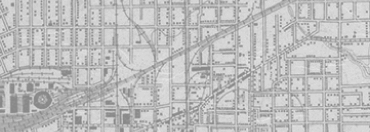


Back
Photograph of courtroom sketch of Dr. Towler and the examination of Ruby's EEGs
Photograph of courtroom pencil sketch on paper by CBS News courtroom artist Howard Brodie. The sketch shows a group consisting of attorneys and members of the jury during the Jack Ruby trial on March 10, 1964. The sketch shows the group of attorneys and jury members clustered around witness Dr. Martin L. Towler as they examine Jack Ruby's EEGs, used as medical evidence for Ruby's insanity defense plea. Individual figures that can be identified include defense attorney Joe Tonahill, Assistant District Attorney Bill Alexander, and defense attorney Melvin Belli. Each of these figured, including Dr. Towler, are identified by the artist with small arrows and captions indicating their identities. Handwritten captions along the upper edge and bottom edge of the image read respectively "Dr Towler and his enceflograms," "3/10/64."The artist's signature "Howard Brodie '64" is located in the lower right under the sketch. Brodie made the original pencil sketches for CBS News during the trial of Jack Ruby after the judge barred cameras from the courtroom. Brodie then gave Joe Tonahill this photograph of a courtroom sketch as part of a collection of more than 40 in 1964.
Photograph of courtroom sketch of Dr. Towler and the examination of Ruby's EEGs
03/10/1964
Paper, Adhesive tape
16 1/16 × 19 15/16 in. (40.8 × 50.6 cm)
Tonahill Family Partners Collection/The Sixth Floor Museum at Dealey Plaza
2014.034.0019
Howard Brodie (1915-2010) was a sports artist for the San Francisco Chronicle when he enlisted in the U.S. Army with America's entry into World War II. He ultimately became one of the best-known sketch artists of the war, frequently published in the weekly U.S. military magazine, Yank, which ran from June 1942 to December 1945. After the war, Brodie spent the next thirty-five years as a courtroom artist, attending several notable trials including the Chicago Seven, Charles Manson and, of course, the Jack Ruby trial in 1964. For the Ruby trial, Brodie worked as a CBS-TV artist correspondent. Mr. Brodie recorded an oral history with the Museum in 2006. -- Stephen Fagin, Curator
Dr. Martin Lee Towler (1910-1993) was a founding member and onetime president of the American Medical Electroencephalographic Association. A native Texan, Towler was on the staff of the University of Texas branch hospital in Galveston at the time of the Jack Ruby trial. Although Towler was initially appointed by Judge Joe B. Brown as a neurological consultant, after Towler's report did not support the prosecution's case, he became a defense witness. Towler found "abnormalities" in Ruby's EEG charts, and he concluded that Ruby suffered from "a seizure disorder... of psychomotor variant." As Dr. Towler explained, someone suffering from this psychomotor epilespy "can perform [their] ordinary everyday routine with a high degree of percision." However, he continued, the person would be "behaving as an automaton... Most patients will be amnesic for the entire episode..." -- Stephen Fagin, Curator
Photograph of courtroom sketch of Dr. Towler and the examination of Ruby's EEGs
Photograph of courtroom pencil sketch on paper by CBS News courtroom artist Howard Brodie. The sketch shows a group consisting of attorneys and members of the jury during the Jack Ruby trial on March 10, 1964. The sketch shows the group of attorneys and jury members clustered around witness Dr. Martin L. Towler as they examine Jack Ruby's EEGs, used as medical evidence for Ruby's insanity defense plea. Individual figures that can be identified include defense attorney Joe Tonahill, Assistant District Attorney Bill Alexander, and defense attorney Melvin Belli. Each of these figured, including Dr. Towler, are identified by the artist with small arrows and captions indicating their identities. Handwritten captions along the upper edge and bottom edge of the image read respectively "Dr Towler and his enceflograms," "3/10/64."The artist's signature "Howard Brodie '64" is located in the lower right under the sketch. Brodie made the original pencil sketches for CBS News during the trial of Jack Ruby after the judge barred cameras from the courtroom. Brodie then gave Joe Tonahill this photograph of a courtroom sketch as part of a collection of more than 40 in 1964.
Photograph of courtroom sketch of Dr. Towler and the examination of Ruby's EEGs
03/10/1964
Photographs
Jack Ruby trial
Sketches
Insanity
EEG
Trials
Medical records
Artist
Artwork
Brodie, Howard
Towler, Martin L., M.D.
Tonahill, Joe H.
Belli, Melvin
Alexander, William F.
CBS News
Dallas
Paper, Adhesive tape
16 1/16 × 19 15/16 in. (40.8 × 50.6 cm)
Tonahill Family Partners Collection/The Sixth Floor Museum at Dealey Plaza
2014.034.0019
Howard Brodie (1915-2010) was a sports artist for the San Francisco Chronicle when he enlisted in the U.S. Army with America's entry into World War II. He ultimately became one of the best-known sketch artists of the war, frequently published in the weekly U.S. military magazine, Yank, which ran from June 1942 to December 1945. After the war, Brodie spent the next thirty-five years as a courtroom artist, attending several notable trials including the Chicago Seven, Charles Manson and, of course, the Jack Ruby trial in 1964. For the Ruby trial, Brodie worked as a CBS-TV artist correspondent. Mr. Brodie recorded an oral history with the Museum in 2006. -- Stephen Fagin, Curator
Dr. Martin Lee Towler (1910-1993) was a founding member and onetime president of the American Medical Electroencephalographic Association. A native Texan, Towler was on the staff of the University of Texas branch hospital in Galveston at the time of the Jack Ruby trial. Although Towler was initially appointed by Judge Joe B. Brown as a neurological consultant, after Towler's report did not support the prosecution's case, he became a defense witness. Towler found "abnormalities" in Ruby's EEG charts, and he concluded that Ruby suffered from "a seizure disorder... of psychomotor variant." As Dr. Towler explained, someone suffering from this psychomotor epilespy "can perform [their] ordinary everyday routine with a high degree of percision." However, he continued, the person would be "behaving as an automaton... Most patients will be amnesic for the entire episode..." -- Stephen Fagin, Curator









